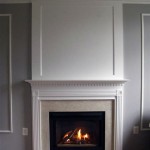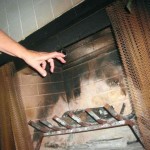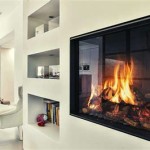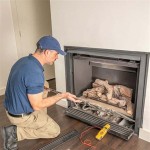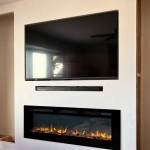Gas Built-In Fireplaces: A Comprehensive Overview
Gas built-in fireplaces represent a significant segment of the home heating and ambiance market. These appliances offer a blend of convenience, aesthetics, and controlled heating capabilities, making them a popular choice for both new construction and renovation projects. Unlike traditional wood-burning fireplaces, gas built-in models eliminate the need for wood storage, hauling, and the associated mess. They also provide a consistent and easily adjustable heat output, controlled by a thermostat or remote control. This article explores the key features, considerations, and benefits of gas built-in fireplaces, providing a thorough understanding of their functionality and applications.
The term "built-in" denotes that the fireplace is designed to be integrated into the structure of a wall or existing fireplace opening. This contrasts with freestanding gas fireplaces, which are self-contained units. Built-in models typically require professional installation to ensure proper gas line connections, venting, and adherence to local building codes. The installation process is a critical factor in both the safety and performance of the fireplace.
Key Features and Components
A gas built-in fireplace comprises several key components that work in concert to produce heat and a realistic flame effect. Understanding these components is essential for informed decision-making when selecting and maintaining a gas fireplace.
The burner system is the heart of the fireplace, responsible for igniting and maintaining the gas flame. Burners are typically constructed from stainless steel or cast iron for durability and resistance to corrosion. Different burner designs produce varying flame patterns, from a single, concentrated flame to a wide, dispersed flame. The burner system also includes the gas valve, which controls the flow of gas to the burner, and the ignition system, which initiates the combustion process. Ignition systems can be either electronic or utilize a standing pilot light. Electronic ignition is more energy-efficient, as it only consumes gas when the fireplace is in use, while standing pilot lights continuously burn a small amount of gas.
The firebox is the enclosed chamber that houses the burner system and simulated logs or decorative media. The firebox is typically constructed from steel or cast iron and is designed to withstand high temperatures. The interior of the firebox may be lined with refractory materials, such as firebrick or ceramic panels, to further enhance heat retention and distribution. These refractory materials also contribute to the realistic appearance of a wood-burning fireplace.
The venting system is crucial for safely exhausting combustion byproducts, such as carbon dioxide and water vapor, from the fireplace. Gas fireplaces typically utilize one of two types of venting: direct vent or B-vent. Direct vent systems draw combustion air from outside the home and exhaust combustion gases directly to the outside, creating a sealed combustion chamber. This type of venting is considered the safest and most efficient option. B-vent systems draw combustion air from inside the home and exhaust combustion gases through a dedicated vent pipe. B-vent systems are less efficient than direct vent systems and require careful installation to ensure proper venting and prevent backdrafting of combustion gases into the home.
Decorative media, such as ceramic logs, glass beads, or stones, are placed in the firebox to create a realistic and visually appealing flame effect. Ceramic logs are designed to resemble natural wood logs, with intricate details and textures. Glass beads and stones offer a more contemporary aesthetic. The choice of decorative media is largely a matter of personal preference.
Control systems regulate the operation of the fireplace, including ignition, flame height, and heat output. Control systems can range from simple on/off switches to sophisticated electronic controls with thermostats, timers, and remote control capabilities. Some gas fireplaces also offer smart home integration, allowing users to control the fireplace from their smartphones or other devices.
Advantages of Gas Built-In Fireplaces
Gas built-in fireplaces offer numerous advantages over traditional wood-burning fireplaces and other heating options. These advantages contribute to their popularity among homeowners seeking a convenient, efficient, and aesthetically pleasing heating solution.
Convenience is a primary benefit. Gas fireplaces eliminate the need for wood storage, hauling, and splitting. They are easy to operate, with instant on/off functionality and adjustable flame height. The absence of ash and soot reduces the need for frequent cleaning. This convenience makes gas fireplaces an attractive option for individuals with busy lifestyles or those who prefer a low-maintenance heating solution.
Efficiency is another significant advantage. Gas fireplaces are generally more energy-efficient than wood-burning fireplaces, as they convert a higher percentage of fuel into usable heat. Direct vent gas fireplaces are particularly efficient, as they draw combustion air from outside the home and minimize heat loss. The ability to control the flame height and heat output allows users to tailor the fireplace's operation to their specific heating needs, further enhancing efficiency.
Safety is a paramount consideration. Gas fireplaces are safer than wood-burning fireplaces, as they eliminate the risk of sparks, embers, and creosote buildup. Direct vent gas fireplaces are particularly safe, as they create a sealed combustion chamber that prevents combustion gases from entering the home. Modern gas fireplaces are equipped with safety features, such as automatic shut-off valves and oxygen depletion sensors, to further enhance safety.
Aesthetics are a key driver for many homeowners. Gas fireplaces offer a wide range of design options, from traditional to contemporary, allowing users to customize the appearance of their fireplace to complement their home décor. The ability to choose from various decorative media, such as ceramic logs, glass beads, or stones, further enhances the aesthetic appeal. The realistic flame effect of modern gas fireplaces mimics the ambiance of a wood-burning fireplace without the associated drawbacks.
Air quality is improved with gas fireplaces. Compared to wood-burning fireplaces, gas fireplaces produce significantly fewer emissions, contributing to better indoor and outdoor air quality. The combustion of natural gas or propane produces primarily carbon dioxide and water vapor, with minimal particulate matter or other pollutants. This makes gas fireplaces a more environmentally friendly heating option.
Installation and Maintenance Considerations
Proper installation and regular maintenance are essential for ensuring the safe and efficient operation of a gas built-in fireplace. Improper installation can lead to gas leaks, carbon monoxide poisoning, or other hazards. Neglecting maintenance can result in reduced efficiency, poor performance, and premature component failure.
Professional installation is highly recommended. Gas fireplaces require specialized knowledge and skills to install correctly. A qualified technician will ensure proper gas line connections, venting, and adherence to local building codes. The installation process typically involves running a gas line to the fireplace location, installing the venting system, and connecting the fireplace to the gas line. The technician will also test the fireplace to ensure that it is operating safely and efficiently.
Regular inspections are crucial for identifying potential problems before they escalate. It is recommended to have the fireplace inspected annually by a qualified technician. The inspection should include a visual examination of the burner system, venting system, and control system. The technician will also check for gas leaks, carbon monoxide leaks, and other hazards.
Cleaning and maintenance tasks should be performed regularly. The frequency of cleaning and maintenance will depend on the frequency of use and the specific model of fireplace. Common tasks include cleaning the glass front, removing dust and debris from the burner system, and inspecting the venting system for obstructions. The use of appropriate cleaning products is essential to avoid damaging the fireplace components.
Troubleshooting common problems can often be addressed with simple solutions. If the fireplace fails to ignite, check the gas supply and the ignition system. If the flame is weak or irregular, clean the burner system and adjust the gas pressure. If the fireplace produces unusual odors or noises, contact a qualified technician for assistance.
Safety precautions must be observed at all times. Never attempt to repair or modify a gas fireplace without proper training and experience. Always turn off the gas supply before performing any maintenance. Install carbon monoxide detectors in the home and test them regularly. Ensure that the venting system is properly maintained and free of obstructions.
Choosing a gas built-in fireplace requires careful consideration of factors such as heating needs, aesthetic preferences, and budget. The ongoing costs of operation and maintenance should also be factored into the decision-making process. By understanding the key features, advantages, and considerations outlined in this article, homeowners can make an informed choice and enjoy the benefits of a safe, efficient, and aesthetically pleasing gas fireplace.
How To For A Gas Fireplace Fireplaces Direct Learning Center

Heatmaster Enviro High Efficient Gas Fireplace

Heat Glo True Built In Gas Fireplace

Built In Flueless Gas Fireplace Ing Fireplaces

Safire Built In Gas Fireplace Hyper Fires Fireplaces Cape Town

Enclosed Gas Fireplaces Jetmaster

How To Operate A Gas Fireplace

ᑕ❶ᑐ How Much Do Fireplace Built Ins Cost Get The Guide

6 Reasons To Switch A Gas Fireplace 2nd Generation Chimneys Inc
:max_bytes(150000):strip_icc()/ventless-gas-fireplaces-4160746-hero-f9d4bdcd9bd446eb84406de306f790ba.jpg?strip=all)
How To Pick Out A Ventless Gas Fireplace
Related Posts

